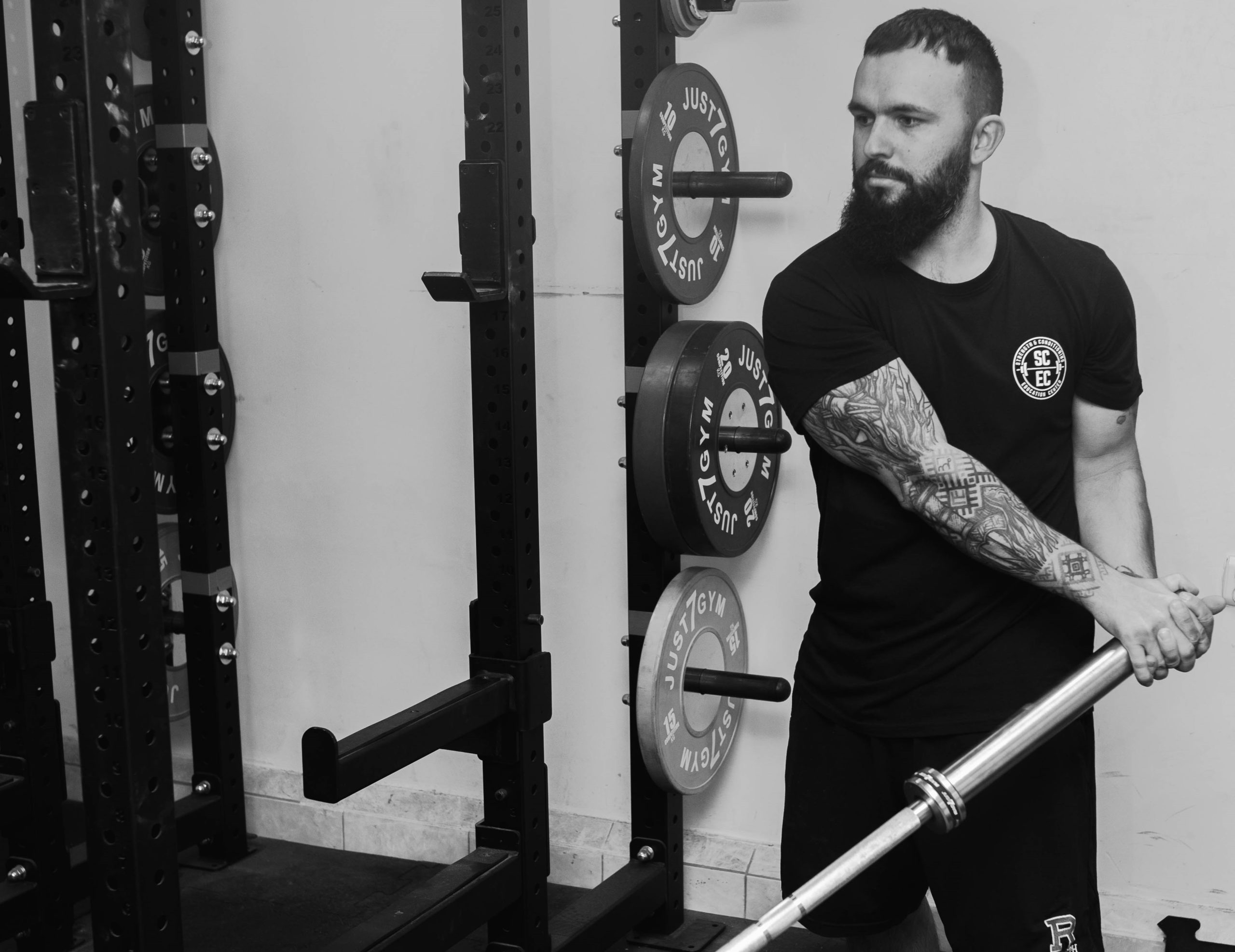
Wielu sportowców oraz ludzi aktywnych często mówi o mięśniach brzucha lub tak zwanym „sześciopaku”. Mimo tego że każdy z nas ma różne cele to 9 na 10 osób chciałoby mieć umięśniony brzuch na którym widać było by tzw. „kaloryfer” lub przynajmniej na którym nie zbierało by się aż tak dużo tłuszczu!
Niestety w dzisiejszych czasach praktycznie wszyscy robią dwa podstawowe błędy:
1. Ćwiczą mięśnie brzucha codziennie lub kilka razy w tygodniu wykonując ćwiczenia izolujące ze zbyt dużą ilością powtórzeń.
2. Nie trenują mięśni brzucha zgodnie z jego funkcją co prowadzi do bólu pleców oraz do nie osiągania zamierzonych celów.
ZA CO ODPOWIADAJĄ MIĘŚNIE BRZUCHA
Główną funkcją mięśni brzucha jest stabilizacja kręgosłupa oraz transfer energii oraz mocy wytwarzanej przed dolną część ciała a dokładniej przez biodra. Jeden z największych specjalistów na świecie w tych sprawach Stuart McGill powiedział że im więcej ruchu w okolicach dolnego odcinka lędźwiowego (w co wchodzą mięśnie brzucha) tym większe ryzyko urazu pleców. Problemy z odcinkiem lędźwiowym to w tej chwili najczęstszy uraz na świecie. Większość ludzi poprzez siedzący tryb życia ma pochyloną do przodu głowę oraz zaokrąglone ramiona. Co ci ludzie zazwyczaj robią chcąc zrzucić zbędny tłuszcz i zbudować kaloryfer? Oczywiście BRZUSZKI, co tylko utwierdza powyższą wadę postawy oraz prowadzi do dalszych problemów z kręgosłupem.
Ale przecież wszyscy robią dużo powtórzeń brzuszków bo wtedy czujemy “pieczenie” tzn że działa…. BŁĄD!!!
Uczucie pieczenia to akumulacja jonów wodorowych i nie ma to nic wspólnego z budowaniem sześciopaka oraz silnego i zdrowego korpusu.
W JAKI SPOSÓB MOŻNA TRENOWAĆ MIĘŚNIE BRZUCHA
1. Ćwiczenia siłowe (przysiady ze sztangą, martwe ciągi, podnoszenie ciężarów w stylu Olimpijskim, pompki, wyciskanie sztangi stojąc, podciąganie na drążku itd.)
2. Stabilizacja w trzech płaszczyznach
a. Stabilizacja przeciw wygięciu – rodzaje plank-ów (deska)
b. Stabilizacja przeciw zgięciu bocznym – rodzaje plank-ów bokiem
c. Stabilizacja przeciw rotacji
>>>> FAKT: Świetnym ćwiczeniem które stabilizuje, wzmacnia oraz spala tłuszcz jest spacer farmera (w szczególności dobrze działa na nasze “boczki”)
3. Dynamicze ćwiczenia z piłką lekarską, gdzie skupiamy się na ruchu bioder oraz odcinka piersiowego w trakcie dynamicznych rzutów o ścianę lub w podłogę
4. Sprinty interwałowe
5. Przyciąganie nóg do ramion wisząc lub na ławeczce skośnej.
6. Przyciąganie ramion do nóg – najczęściej używane a powinno być wykonywane sporadycznie lub w ogóle.
Często spotykam się z pytaniem: Jak zrzucić tłuszcz z dolnej części brzucha lub jakie ćwiczenia wykonywać na dolne mięśnie brzucha. NIE MA CZEGOŚ TAKIEGO JAK DOLNE MIĘŚNIE BRZUCHA LUB GÓRNE MIĘŚNIE BRZUCHA. Ostatni raz jak sprawdzałem to wszyscy mają tylko jeden, długi mięsień prosty brzucha połączony z naszym mostkiem oraz kością łonową. Nie jest możliwe żeby ten mięsień w jakikolwiek sposób podzielić na dwie części żeby skupić się nad pracą dolnej części a wyeliminować górną część i vice versa.
Często również ludzie myślą że jeżeli schudną to będzie u nich widać mięśnie brzucha. Prawdą jest że jeżeli ktoś ćwiczy siłowo, biega sprinty ale ma lekką nadwagę to zrzucenie paru kilogramów podkreśli jego sylwetkę ale jeżeli zwykła osoba nie trenująca siłowo po prostu schudnie to mięśni brzucha jak nie było, tak nie będzie.
Popatrzcie jak chudzi są maratończycy a często nie widać u nich sześciopaku. Z drugiej strony zwróćcie uwagę na sprinterów i na to jak bardzo mają zarysowane mięśnie brzucha. Dlaczego tak się dzieje? Sprinterzy trenują siłowo, dynamicznie plus oczywiście wykonują sprinty.
>>>>> FAKT: Jeżeli chcesz zrzucić zbędny tłuszcz z brzucha to nie obniżaj drastycznie kalorii ponieważ razem z tym obniży się twój metabolizm i ciało automatycznie będzie spalało mniej kalorii w ciągu dnia. Poza tym podniesie się twój kortyzol co prowadzi do odkładania tłuszczu oraz szeregu innych problemów.
JAK WIĘC ZBUDOWAĆ SILNE, STABILNE A W SZCZEGÓLNOŚCI WIDOCZNE MIĘŚNIE BRZUCHA?
1. Wykonuj ćwiczenia siłowe takie jak przysiady ze sztangą, martwe ciągi, podnoszenie ciężarów w stylu Olimpijskim, pompki, wyciskanie sztangi stojąc, podciąganie na drążku itd.
2. Wykonuj sprinty interwałowe (zapomnij o biegach długodystansowych)
3. Obniż ilość spożywanych węglowodanów w szczególności tych z mąki i ziaren a skup się na warzywach oraz ciemnego koloru owocach. Twój największy posiłek węglowodanowy powinien być spożywany bezpośrednio po treningu. PS: Ten punkt zasługuje na oddzielny, bardziej rozwinięty artykuł.
4. Wykonuj selektywnie wybrane ćwiczenia na brzuch takie jak: spacer farmera, rzuty piłką lekarską, podnoszenie nóg leżąc lub wisząc, brzuszki Jandy, wymachy młotem kowalskim lub landmine (mina) – nie przekraczaj liczby 20 powtórzeń a większości 10-15 powtórzeń. Przy niektórych ćwiczeniach 5 powtórzeń będzie optymalnym celem.
DODATKOWE INFORMACJE:
1. Zdrowy, silny korpus charakteryzuje się stabilnością tak więc powinniśmy być w stanie wytrzymać w pozycji plank (deska) przez 2 minuty oraz w pozycji side plank (deska bokiem) przez 90 sekund na stronę przy zachowaniu perfekcyjnej techniki.
2. Nie wykonuj dużej ilości ćwiczeń na brzuch pomiędzy ćwiczeniami siłowymi które angażują korpus takie jak przysiad, martwy ciąg, wyciskanie stojąc itd. Może to osłabić twój korpus który potrzebuje być mocny oraz stabilny podczas ćwiczeń siłowych.
Dziękuję,
Mirek Babiarz, MS, CSCS, USAW, PES, FMS
SCEC.
Many athletes and active people often speak of the abdominal muscles or the so-called „six-pack”. Despite the fact that each person has different goals, 9 out of 10 people would like to have visible abdominals.
Unfortunately, nowadays virtually everyone makes two fundamental errors when training their abdominals:
1. Training abdominal muscles too frequently meaning every day or several times a week performing isolating exercises with too many repetitions.
2. Not training the abdominal muscles in accordance with its function, which leads to back pain and not achieving the desired objectives.
WHAT ARE THE ABDOMINAL MUSCLES RESPONSIBLE FOR
The main function of the abdominal muscles is to stabilize the spine and transfer the energy and power produced by the lower body (hips). One of the biggest back and core specialists in the world Stuart McGill has spoken at length about how spine range of motion and power are positively correlated with injury risk. In other words, the more your spine moves (to create force, as opposed to simply transferring it), the more likely you are to get hurt. How do you prevent your spine from moving excessively? You stabilize your core. Back pain is now the most common injury in the world. Because of a sedentary lifestyle most people possess forward head posture and rounded shoulders. And guess what most of those people do when they are trying to acquire a six-pack? Of course crunches, which only reinforces the above posture problems and leads to further problems with the spine.
But everyone does high repetition of crunches because then we feel the „burning” sensation, which means we are shedding fat and building our six-pack muscles!!! – WRONG!!!! This burning sensation is actually an accumulation of hydrogen ions and it has nothing to do with building a six-pack and having a strong and healthy core. As Pavel Tsatsouline said: High repetitions develop muscular endurance. In the case of the 15-50 rep range most 'shapers’ and 'toners’ use, it is anaerobic, or short term, endurance. In this mode your muscles burn glycogen, a form of sugar, for fuel. It is stored, among other places, in the muscles. High rep training depletes your glycogen reserves. To prevent such a critical situation in the future, your body will store more glycogen than before. Now here is the catch. Each molecule of this sub- stance binds with three molecules of water. Jiggle, jiggle! You look like you could cross the Sahara desert without refueling!
HOW CAN WE TRAIN THE ABDOMINALS MUSCLES
1. Compound movements (barbell squats, deadlifts, hip thrusts, Olympic lifts, push-ups, standing barbell presses, curls, bench press, pull-ups etc.)
2. Stabilization in three planes
a. Anti extension – types of front plank movements
b. Anti lateral flexion – types of side plank movements
c. Anti rotation – types of anti rotation movements
(FACT: A great exercise to stabilize, strengthen core and burn fat is the farmer’s walk).
3. Dynamic exercises with a medicine ball, where the focus is on core stabilization and movement of the hips and thoracic spine during dynamic throws against the wall or the floor
4. Interval Sprints
5. Raising legs towards the arms/shoulders by hanging from a chin-up bar or on an incline bench
6. Moving arms/shoulders towards the legs – the most commonly used movement (should be performed occasionally)
I often hear the question: How do I train the lower abs? No such thing as the lower or upper abdominal muscles. Last time I checked there is only one, long muscle, rectus abdominis, connecting your sternum and your pubic bone.It is impossible to selectively develop a part of a single muscle.
Often people think that if they simply lose weight they will be able to see their abdominal muscles. It is true that if someone is lifting heavy weights and running sprints but is slightly overweight, that person will likely have visible abs if they lose some weight. But if a regular person loses weight, there is no way that abs will beautifully appear just because they’re skinny. Look how skinny the marathon runners are and often they do not posses a well-defined abdominals (and those are world-class athletes). On the other hand, look at the short distance runners and sprinters and how visible their abdominal muscles are. Why? Because they train with heavy weights, they train for power, and of course, they do sprints.
FACT: If you want to loose excess fat from the abdomen, do not dramatically lower your daily calories because along with the calories your metabolism will slow down as well and your body will automatically burn fewer calories throughout the day. In addition, lowering your daily calories significantly will increase the cortisol hormone, which leads to fat accumulation and a number of other problems.
HOW TO BUILD STRONG, HEALTHY AND MOST IMPORTANTLY VISIBLE ABDOMINAL MUSCLES?
1. Perform strength exercises such as squats with a barbell, deadlifts, hip thrusts and glute bridges, Olympic lifts, push-ups, overhead presses and bench presses, pull-up and chin-ups etc.
2. Perform intervals (forget about long-distance cardio)
3. Reduce your intake of carbohydrates, in particular flour and grain based products and focus on vegetables and dark-colored fruits for your carbohydrate intake. Your biggest carbohydrate meal should be consumed immediately after training. PS: This point deserves a separate, more in-depth article.
4. Follow selectively chosen exercises for the abdomen, such as: farmer’s walks, medicine ball throws, hanging leg raises, Janda sit-ups, tire sledgehammers, landmines, bar or swiss ball rollouts, one arm deadlifts etc. – do not exceed 15 repetitions per set and most of the time 10-12 repetitions. For some exercises, 5 reps is the optimal goal.
ADDITIONAL INFORMATION:
1. A healthy, strong core is characterized by stability so we should be able to withstand in the front plank position for 2 minutes and the side plank position for 90 seconds per side while maintaining perfect technique.
2. Do not perform high repetition exercises for the abdomen between heavy strength exercises that engage the core such as the squat, deadlift, Olympic lifts, bench press, standing press etc. This can weaken your core and decrease your overall performance along with increased injury risk.
Thank You,
Mirek Babiarz, MS, CSCS, USAW, PES, FMS
SCEC.



